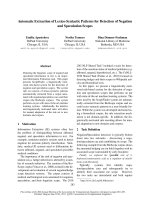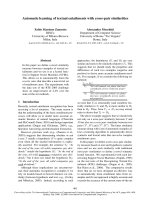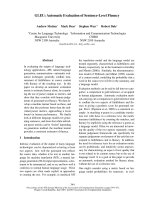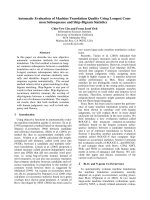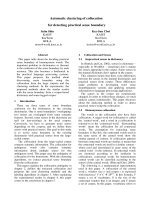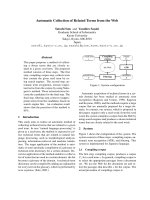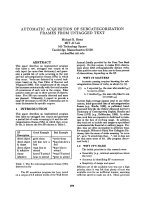Báo cáo khoa học: "Automatic Evaluation of Chinese Translation Output: Word-Level or Character-Level" doc
Bạn đang xem bản rút gọn của tài liệu. Xem và tải ngay bản đầy đủ của tài liệu tại đây (154.28 KB, 6 trang )
Proceedings of the 49th Annual Meeting of the Association for Computational Linguistics:shortpapers, pages 159–164,
Portland, Oregon, June 19-24, 2011.
c
2011 Association for Computational Linguistics
Automatic Evaluation of Chinese Translation Output:
Word-Level or Character-Level?
Maoxi Li Chengqing Zong Hwee Tou Ng
National Laboratory of Pattern Recognition
Institute of Automation, Chinese Academy of
Sciences, Beijing, China, 100190
Department of Computer Science
National University of Singapore
13 Computing Drive, Singapore 117417
{mxli, cqzong}@nlpr.ia.ac.cn
Abstract
Word is usually adopted as the smallest unit in
most tasks of Chinese language processing.
However, for automatic evaluation of the quali-
ty of Chinese translation output when translat-
ing from other languages, either a word-level
approach or a character-level approach is possi-
ble. So far, there has been no detailed study to
compare the correlations of these two ap-
proaches with human assessment. In this paper,
we compare word-level metrics with character-
level metrics on the submitted output of Eng-
lish-to-Chinese translation systems in the
IWSLT’08 CT-EC and NIST’08 EC tasks. Our
experimental results reveal that character-level
metrics correlate with human assessment better
than word-level metrics. Our analysis suggests
several key reasons behind this finding.
1 Introduction
White space serves as the word delimiter in Latin
alphabet-based languages. However, in written
Chinese text, there is no word delimiter. Thus, in
almost all tasks of Chinese natural language
processing (NLP), the first step is to segment a
Chinese sentence into a sequence of words. This is
the task of Chinese word segmentation (CWS), an
important and challenging task in Chinese NLP.
Some linguists believe that word (containing at
least one character) is the appropriate unit for Chi-
nese language processing. When treating CWS as a
standalone NLP task, the goal is to segment a sen-
tence into words so that the segmentation matches
the human gold-standard segmentation with the
highest F-measure, but without considering the
performance of the end-to-end NLP application
that uses the segmentation output. In statistical
machine translation (SMT), it can happen that the
most accurate word segmentation as judged by the
human gold-standard segmentation may not
produce the best translation output (Zhang et al.,
2008). While state-of-the-art Chinese word
segmenters achieve high accuracy, some errors still
remain.
Instead of segmenting a Chinese sentence into
words, an alternative is to split a Chinese sentence
into characters, which can be readily done with
perfect accuracy. However, it has been reported
that a Chinese-English phrase-based SMT system
(Xu et al., 2004) that relied on characters (without
CWS) performed slightly worse than when it used
segmented words. It has been recognized that vary-
ing segmentation granularities are needed for SMT
(Chang et al., 2008).
To evaluate the quality of Chinese translation
output, the International Workshop on Spoken
Language Translation in 2005 (IWSLT'2005) used
the word-level BLEU metric (Papineni et al.,
2002). However, IWSLT'08 and NIST'08 adopted
character-level evaluation metrics to rank the sub-
mitted systems. Although there is much work on
automatic evaluation of machine translation (MT),
whether word or character is more suitable for au-
tomatic evaluation of Chinese translation output
has not been systematically investigated.
In this paper, we utilize various machine transla-
tion evaluation metrics to evaluate the quality of
Chinese translation output, and compare their cor-
relation with human assessment when the Chinese
translation output is segmented into words versus
characters. Since there are several CWS tools that
can segment Chinese sentences into words and
their segmentation results are different, we use four
representative CWS tools in our experiments. Our
experimental results reveal that character-level me-
159
trics correlate with human assessment better than
word-level metrics. That is, CWS is not essential
for automatic evaluation of Chinese translation
output. Our analysis suggests several key reasons
behind this finding.
2 Chinese Translation Evaluation
Automatic MT evaluation aims at formulating au-
tomatic metrics to measure the quality of MT out-
put. Compared with human assessment, automatic
evaluation metrics can assess the quality of MT
output quickly and objectively without much hu-
man labor.
Figure 1. An example to show an MT system translation
and multiple reference translations being segmented into
characters or words.
To evaluate English translation output, automat-
ic MT evaluation metrics take an English word as
the smallest unit when matching a system transla-
tion and a reference translation. On the other hand,
to evaluate Chinese translation output, the smallest
unit to use in matching can be a Chinese word or a
Chinese character. As shown in Figure 1, given an
English sentence “how much are the umbrellas?” a
Chinese system translation (or a reference transla-
tion) can be segmented into characters (Figure 1(a))
or words (Figure 1(b)).
A variety of automatic MT evaluation metrics
have been developed over the years, including
BLEU (Papineni et al., 2002), NIST (Doddington,
2002), METEOR (exact) (Banerjee and Lavie,
2005), GTM (Melamed et al., 2003), and TER
(Snover et al., 2006). Some automatic MT evalua-
tion metrics perform deeper linguistic analysis,
such as part-of-speech tagging, synonym matching,
semantic role labeling, etc. Since part-of-speech
tags are only defined for Chinese words and not for
Chinese characters, we restrict the automatic MT
evaluation metrics explored in this paper to those
metrics listed above which do not require part-of-
speech tagging.
3 CWS Tools
Since there are a number of CWS tools and they
give different segmentation results in general, we
experimented with four different CWS tools in this
paper.
ICTCLAS: ICTCLAS has been successfully used
in a commercial product (Zhang et al., 2003). The
version we adopt in this paper is ICTCLAS2009.
NUS Chinese word segmenter (NUS): The NUS
Chinese word segmenter uses a maximum entropy
approach to Chinese word segmentation, which
achieved the highest F-measure on three of the four
corpora in the open track of the Second Interna-
tional Chinese Word Segmentation Bakeoff (Ng
and Low, 2004; Low et al., 2005). The segmenta-
tion standard adopted in this paper is CTB (Chi-
nese Treebank).
Stanford Chinese word segmenter
(STANFORD): The Stanford Chinese word seg-
menter is another well-known CWS tool (Tseng et
al., 2005). The version we used was released on
2008-05-21 and the standard adopted is CTB.
Urheen: Urheen is a CWS tool developed by
(Wang et al., 2010a; Wang et al., 2010b), and it
outperformed most of the state-of-the-art CWS
systems in the CIPS-SIGHAN’2010 evaluation.
This tool is trained on Chinese Treebank 6.0.
4 Experimental Results
4.1 Data
To compare the word-level automatic MT evalua-
tion metrics with the character-level metrics, we
conducted experiments on two datasets, in the spo-
ken language translation domain and the newswire
translation domain.
Translation: 多_少_钱_的_伞_吗_?
Ref 1: 这_些_雨_伞_多_少_钱_?
……
Ref 7: 这_些_雨_伞_的_价_格_是_多_少_?
(a) Segmented into characters.
Translation: 多少_钱_的_伞_吗_?
Ref 1: 这些_雨伞_多少_钱_?
……
Ref 7: 这些_雨伞_的_价格_是_多少_?
(b)
Segmented into words by Urheen.
160
The IWSLT'08 English-to-Chinese ASR chal-
lenge task evaluated the translation quality of 7
machine translation systems (Paul, 2008). The test
set contained 300 segments with human assess-
ment of system translation quality. Each segment
came with 7 human reference translations. Human
assessment of translation quality was carried out
on the fluency and adequacy of the translations, as
well as assigning a rank to the output of each sys-
tem. For the rank judgment, human graders were
asked to "rank each whole sentence translation
from best to worst relative to the other choices"
(Paul, 2008). Due to the high manual cost, the flu-
ency and adequacy assessment was limited to the
output of 4 submitted systems, while the human
rank assessment was applied to all 7 systems.
Evaluation based on ranking is reported in this pa-
per. Experimental results on fluency and adequacy
judgment also agree with the results on human
rank assessment, but are not included in this paper
due to length constraint.
The NIST'08 English-to-Chinese translation task
evaluated 127 documents with 1,830 segments.
Each segment has 4 reference translations and the
system translations of 11 MT systems, released in
the corpus LDC2010T01. We asked native speak-
ers of Chinese to perform fluency and adequacy
judgment on a five-point scale. Human assessment
was done on the first 30 documents (355 segments)
(document id “AFP_ENG_20070701.0026” to
“AFP_ENG_20070731.0115”). The method of
manually scoring the 11 submitted Chinese system
translations of each segment is the same as that
used in (Callison-Burch et al., 2007). The adequa-
cy score indicates the overlap of the meaning ex-
pressed in the reference translations with a system
translation, while the fluency score indicates how
fluent a system translation is.
4.2 Segment-Level Consistency or Correla-
tion
For human fluency and adequacy judgments, the
Pearson correlation coefficient is used to compute
the segment-level correlation between human
judgments and automatic metrics. Human rank
judgment is not an absolute score and thus Pearson
correlation coefficient cannot be used. We calcu-
late segment-level consistency as follows:
-
-
The consistent number of pair wise comparisons
The total number of pair wise comparisons
Ties are excluded in pair-wise comparison.
Table 1 and 2 show the segment-level consisten-
cy or correlation between human judgments and
automatic metrics. The “Character” row shows the
segment-level consistency or correlation between
human judgments and automatic metrics after the
system and reference translations are segmented
into characters. The “ICTCLAS”, “NUS”,
“STANFORD”, and “Urheen” rows show the
scores when the system and reference translations
are segmented into words by the respective Chi-
nese word segmenters.
The character-level metrics outperform the best
word-level metrics by 2−5% on the IWSLT’08
CT-EC task, and 4−13% on the NIST’08 EC task.
Method BLEU NIST METEOR GTM
1−
TER
Character
0.69 0.73 0.74 0.71 0.60
ICTCLAS 0.64 0.70 0.69 0.66 0.57
NUS 0.64 0.71 0.70 0.65 0.55
STANFORD 0.64 0.69 0.69 0.64 0.54
Urheen 0.63 0.70 0.68 0.65 0.55
Table 1. Segment-level consistency on IWSLT’08 CT-
EC.
Method BLEU NIST METEOR GTM
1−
TER
Character
0.63 0.61 0.65 0.61 0.60
ICTCLAS 0.49 0.56 0.59 0.55 0.51
NUS 0.49 0.57 0.58 0.54 0.51
STANFORD 0.50 0.57 0.59 0.55 0.50
Urheen 0.49 0.56 0.58 0.54 0.51
Table 2. Average segment-level correlation on NIST’08
EC.
4.3 System-Level Correlation
We measure correlation at the system level using
Spearman's rank correlation coefficient. The sys-
tem-level correlations of word-level metrics and
character-level metrics are summarized in Table 3
and 4.
Because there are only 7 systems that have hu-
man assessment in the IWSLT’08 CT-EC task, the
gap between character-level metrics and word-
level metrics is very small. However, it still shows
that character-level metrics perform no worse than
word-level metrics. For the NIST’08 EC task, the
system translations of the 11 submitted MT sys-
tems were assessed manually. Except for the GTM
metric, character-level metrics outperform word-
161
level metrics. For BLEU and TER, character-level
metrics yield up to 6−9% improvement over word-
level metrics. This means the character-level me-
trics reduce about 2−3 erroneous system rankings.
When the number of systems increases, the differ-
ence between the character-level metrics and word-
level metrics will become larger.
Method BLEU NIST METEOR GTM
1−
TER
Character
0.96 0.93 0.96 0.93 0.96
ICTCLAS 0.96 0.93 0.89 0.93 0.96
NUS 0.96 0.93 0.89 0.86 0.96
STANFORD 0.96 0.93 0.89 0.86 0.96
Urheen 0.96 0.93 0.89 0.86 0.96
Table 3. System-level correlation on IWSLT’08 CT-EC.
Method BLEU NIST METEOR GTM
1−
TER
Character
0.97 0.98 1.0 0.99 0.86
ICTCLAS 0.91 0.96 0.99 0.99 0.81
NUS 0.91 0.96 0.99 0.99 0.79
STANFORD 0.89 0.97 0.99 0.99 0.77
Urheen 0.91 0.96 0.99 0.99 0.79
Table 4. System-level correlation on NIST’08 EC.
5 Analysis
We have analyzed the reasons why character-level
metrics better correlate with human assessment
than word-level metrics.
Compared to word-level metrics, character-level
metrics can capture more synonym matches. For
example, Figure 1 gives the system translation and
a reference translation segmented into words:
Translation: 多少_钱_的_
伞
_吗_?
Reference: 这些_
雨伞
_多少_钱_?
The word “
伞
” is a synonym for the word “
雨
伞
”, and both words are translations of the English
word “umbrella”. If a word-level metric is used,
the word “
伞
” in the system translation will not
match the word “
雨伞
” in the reference translation.
However, if the system and reference translation
are segmented into characters, the word “
伞
” in the
system translation shares the same character “
伞
”
with the word “
雨伞
” in the reference. Thus
character-level metrics can better capture synonym
matches.
We can classify the semantic relationships of
words that share some common characters into
three types: exact match, partial match, and no
match. The statistics on the output translations of
an MT system are shown in Table 5. It shows that
“exact match” accounts for 71% (29/41) and “no
match” only accounts for 7% (3/41). This means
that words that share some common characters are
synonyms in most cases. Therefore, character-level
metrics do a better job at matching Chinese transla-
tions.
Total
count
Exact
match
Partial
match
No match
41 29 9 3
Table 5. Statistics of semantic relationships on words
sharing some common characters.
Another reason why word-level metrics perform
worse is that the segmented words in a system
translation may be inconsistent with the segmented
words in a reference translation, since a statistical
word segmenter may segment the same sequence
of characters differently depending on the context
in a sentence. For example:
Translation: 你_在_
京都
_吗_?
Reference: 您_在_
京
_
都
_做_什么_?
Here the word “
京都
” is the Chinese translation
of the English word “Kyoto”. However, it is seg-
mented into two words, “
京
” and “
都
”, in the ref-
erence translation by the same CWS tool. When
this happens, a word-level metric will fail to match
them in the system and reference translation. While
the accuracy of state-of-the-art CWS tools is high,
segmentation errors still exist and can cause such
mismatches.
To summarize, character-level metrics can
capture more synonym matches and the resulting
segmentation into characters is guaranteed to be
consistent, which makes character-level metrics
more suitable for the automatic evaluation of
Chinese translation output.
6 Conclusion
In this paper, we conducted a detailed study of the
relative merits of word-level versus character-level
metrics in the automatic evaluation of Chinese
translation output. Our experimental results have
shown that character-level metrics correlate better
with human assessment than word-level metrics.
Thus, CWS is not needed for automatic evaluation
162
of Chinese translation output. Our study provides
the needed justification for the use of character-
level metrics in evaluating SMT systems in which
Chinese is the target language.
Acknowledgments
This research was done for CSIDM Project No.
CSIDM-200804 partially funded by a grant from
the National Research Foundation (NRF) adminis-
tered by the Media Development Authority (MDA)
of Singapore. This research has also been funded
by the Natural Science Foundation of China under
Grant No. 60975053, 61003160, and 60736014,
and also supported by the External Cooperation
Program of the Chinese Academy of Sciences. We
thank Kun Wang, Daniel Dahlmeier, Matthew
Snover, and Michael Denkowski for their kind as-
sistance.
References
Satanjeev Banerjee and Alon Lavie, 2005. METEOR:
An Automatic Metric for MT Evaluation with
Improved Correlation with Human Judgments.
Proceedings of the ACL Workshop on Intrinsic and
Extrinsic Evaluation Measures for Machine
Translation and/or Summarization, pages 65-72, Ann
Arbor, Michigan, USA.
Chris Callison-Burch, Cameron Fordyce, Philipp
Koehn, Christof Monz and Josh Schroeder, 2007.
(Meta-) Evaluation of Machine Translation.
Proceedings of the Second Workshop on Statistical
Machine Translation, pages 136-158, Prague, Czech
Republic.
Pi-Chuan Chang, Michel Galley and Christopher D.
Manning, 2008. Optimizing Chinese Word
Segmentation for Machine Translation Performance.
Proceedings of the Third Workshop on Statistical
Machine Translation, pages 224-232, Columbus,
Ohio, USA.
George Doddington, 2002. Automatic Evaluation of
Machine Translation Quality Using N-gram Co-
occurrence Statistics. Proceedings of the Second
International Conference on Human Language
Technology Research (HLT'02), pages 138-145, San
Diego, California, USA.
Jin Kiat Low, Hwee Tou Ng and Wenyuan Guo, 2005.
A Maximum Entropy Approach to Chinese Word
Segmentation. Proceedings of the Fourth SIGHAN
Workshop on Chinese Language Processing, pages
161-164, Jeju Island, Korea.
I. Dan Melamed, Ryan Green and Joseph P. Turian,
2003. Precision and Recall of Machine Translation.
Proceedings of the 2003 Conference of the North
American Chapter of the Association for
Computational Linguistics (HLT-NAACL 2003) -
short papers, pages 61-63, Edmonton, Canada.
Hwee Tou Ng and Jin Kiat Low, 2004. Chinese Part-of-
Speech Tagging: One-at-a-Time or All-at-Once?
Word-Based or Character-Based? Proceedings of the
2004 Conference on Empirical Methods in Natural
Language Processing (EMNLP 2004), pages 277-
284, Barcelona, Spain.
Kishore Papineni, Salim Roukos, Todd Ward and Wei-
Jing Zhu, 2002. BLEU: a Method for Automatic
Evaluation of Machine Translation. Proceedings of
the 40th Annual Meeting of the Association for
Computational Linguistics, pages 311-318,
Philadelphia, Pennsylvania, USA.
Michael Paul, 2008. Overview of the IWSLT 2008
Evaluation Campaign. Proceedings of IWSLT 2008,
pages 1-17, Hawaii, USA.
Matthew Snover, Bonnie Dorr, Richard Schwartz, John
Makhoul, Linnea Micciulla and Ralph Makhoul,
2006. A Study of Translation Edit Rate with Targeted
Human Annotation. Proceedings of the Association
for Machine Translation in the Americas, pages 223-
231, Cambridge.
Huihsin Tseng, Pichuan Chang, Galen Andrew, Daniel
Jurafsky and Christopher Manning, 2005. A
Conditional Random Field Word Segmenter for
Sighan Bakeoff 2005. Proceedings of the Fourth
SIGHAN Workshop on Chinese Language
Processing, pages 168-171, Jeju Island, Korea.
Kun Wang, Chengqing Zong and Keh-Yih Su, 2010a. A
Character-Based Joint Model for Chinese Word
Segmentation. Proceedings of the 23rd International
Conference on Computational Linguistics (COLING
2010), pages 1173-1181, Beijing, China.
Kun Wang, Chengqing Zong and Keh-Yih Su, 2010b. A
Character-Based Joint Model for CIPS-SIGHAN
Word Segmentation Bakeoff 2010. Proceedings of
CIPS-SIGHAN Joint Conference on Chinese
Language Processing (CLP2010), pages 245-248,
Beijing, China.
Jia Xu, Richard Zens and Hermann Ney, 2004. Do We
Need Chinese Word Segmentation for Statistical
Machine Translation? Proceedings of the ACL
SIGHAN Workshop 2004, pages 122-128, Barcelona,
Spain.
Hua-Ping Zhang, Qun Liu, Xue-Qi Cheng, Hao Zhang
and Hong-Kui Yu, 2003. Chinese Lexical Analysis
163
Using Hierarchical Hidden Markov Model.
Proceedings of the Second SIGHAN Workshop on
Chinese Language Processing, pages 63-70, Sapporo,
Japan.
Ruiqiang Zhang, Keiji Yasuda and Eiichiro Sumita,
2008. Chinese Word Segmentation and Statistical
Machine Translation. ACM Transactions on Speech
and Language Processing, 5 (2). pages 1-19.
164
